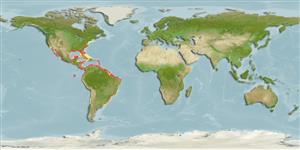Elasmobranchii (tubarões e raias) (sharks and rays) >
Carcharhiniformes (Ground sharks) >
Sphyrnidae (Hammerhead, bonnethead, or scoophead sharks)
Etymology: Sphyrna: Probable misspelling of sphyra (Gr.), hammer, referring to their hammer-shaped heads (See ETYFish); tiburo: From tiburon, Spanish for shark, a name given by 16th- and 17th-century navigators to one or more large species of shark (See ETYFish).
More on author: Linnaeus.
Issue
Sphyrna vespertina in the Eastern Pacific Ocean and Sphyrna alleni from Belize to Brazil, WA (Ref. 132488).
Environment: milieu / Zona climática / intervalo de profundidade / distribution range
Ecologia
marinhas; estuarina associadas(os) a recifes; intervalo de profundidade 10 - 80 m (Ref. 244). Subtropical; 45°N - 36°S, 121°W - 32°W (Ref. 55302)
Western Atlantic: North Carolina, U.S to Belize. Species complex with Sphyrna vespertina in the Eastern Pacific Ocean and Sphyrna alleni from Belize to Brazil, WA (Ref. 132488).
Comprimento de primeira maturação / Tamanho / Peso / Idade
Maturidade: Lm 85.0, range 80 - 90 cm
Max length : 150 cm TL macho/indeterminado; (Ref. 5217); common length : 80.0 cm TL macho/indeterminado; (Ref. 5217); peso máx. publicado: 10.8 kg (Ref. 40637); idade máx. registrada: 12 anos (Ref. 26248)
Front of head semicircular in outline. No other hammerhead has front of head in semicircle. (Ref. 26938).
Body shape (shape guide): elongated.
Found on the continental and insular shelves, on inshore and coastal areas, over mud and sand bottoms, also on coral reefs. Often occur in shallow water including estuaries, shallow bays and over coral reefs (Ref. 9987). Spends night time hours on shallow grass flats, searching for nocturnally active invertebrate prey, moves into deeper water during the day (Ref. 27549). Adults feed mainly on crustaceans, also on bivalves, octopi, and small fish. However, this is the first shark species to demonstrate omnivorous digestive strategy (Ref. 118574). It has been shown through digestability analyses that bonnetheads have enzymes that can digest seagrass organic matter with at least moderate efficiency (Ref. 118574). Viviparous, with 6 to 9 young per litter. Size at birth about 35 to 40 cm. Not territorial. Always occurs in small groups. Considerable sexual segregation occurs. Shows diel rhythm of activity. Utilized for human consumption and processed for fishmeal.
Viviparous, placental (Ref. 50449), with 6 to 9 young per litter. Size at birth about 35 to 40 cm.
Gonzalez, C., B. Postaire, W. Driggers, S. Caballero and D, Chapman, 2024. Sphyrna alleni sp. nov., a new hammerhead shark (Carcharhiniformes, Sphyrnidae) from the Caribbean and the Southwest Atlantic. Zootaxa 5512(4):491-511. (Ref. 132488)
Status na Lista Vermelha da UICN (Ref. 130435: Version 2025-1)
Ameaça para os humanos
Harmless
Uso pelos humanos
Pescarias: espécies comerciais; peixe esportivo: sim
Ferramentas
Relatórios especiais
Baixar XML
Fontes da internet
Estimates based on models
Preferred temperature (Ref.
123201): 21.8 - 28, mean 25 °C (based on 368 cells).
Índice de diversidade filogenética (Ref.
82804): PD
50 = 0.5006 [Uniqueness, from 0.5 = low to 2.0 = high].
Bayesian length-weight: a=0.00204 (0.00116 - 0.00361), b=3.10 (2.94 - 3.26), in cm total length, based on LWR estimates for this species & (Sub)family-body (Ref.
93245).
Nível Trófico (Ref.
69278): 3.9 ±0.0 se; based on diet studies.
Resiliência (Ref.
120179): Muito baixo(a), tempo mínimo de duplicação da população maior que 14 anos (K=0.17-0.34; tm=3; tmax=12; Fec=3).
Fishing Vulnerability (Ref.
59153): High vulnerability (57 of 100).
🛈
Nutrients (Ref.
124155): Calcium = 6.95 [1.35, 35.56] mg/100g; Iron = 0.372 [0.090, 1.111] mg/100g; Protein = 21.3 [19.1, 23.4] %; Omega3 = 0.115 [0.044, 0.282] g/100g; Selenium = 15.4 [4.2, 49.6] μg/100g; VitaminA = 16.5 [4.9, 59.7] μg/100g; Zinc = 0.52 [0.24, 1.15] mg/100g (wet weight);
